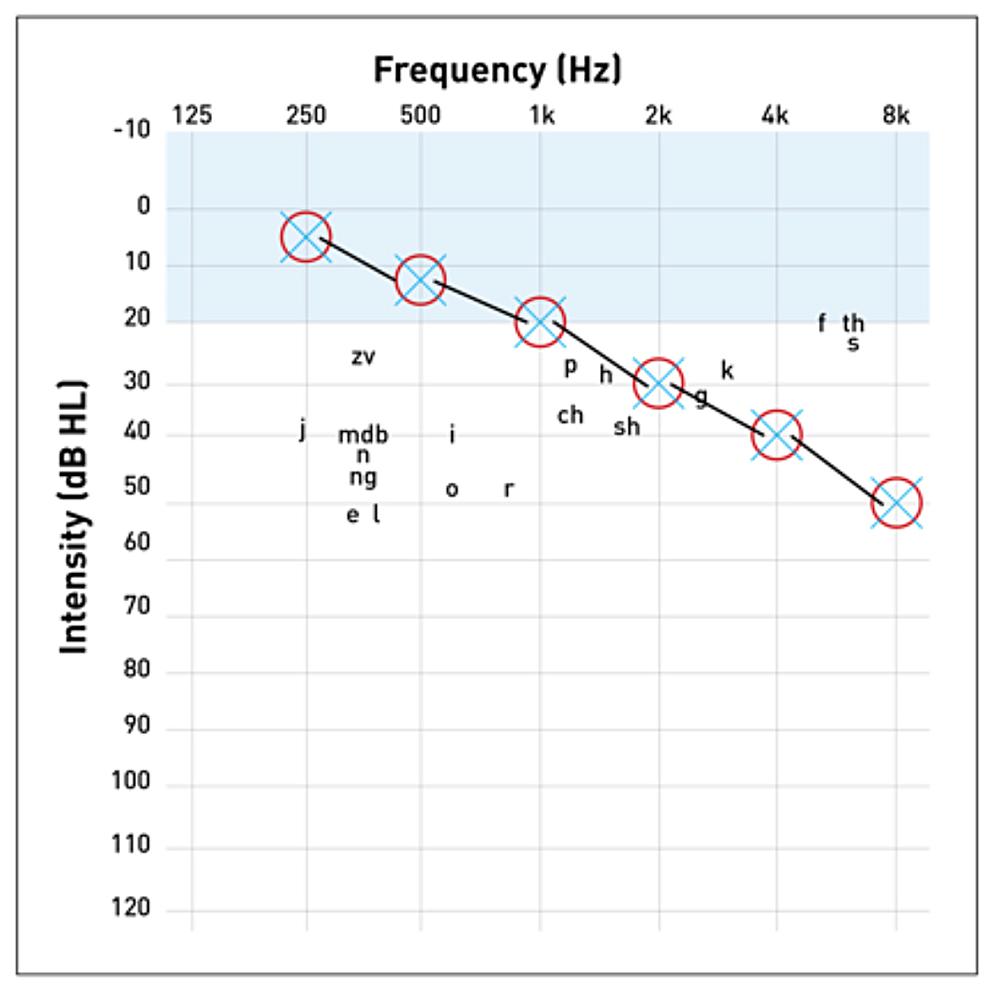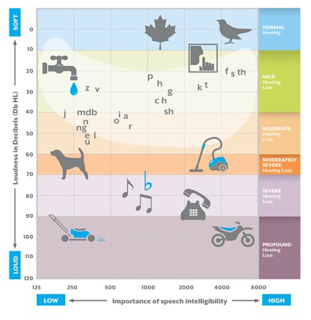Posted Monday December 11, 2023
It is a chart that displays the results of hearing tests that determine how loud a sound needs to be for you to hear it 50% of the time. Any measurements outside the normal ranges may indicate hearing loss.
The specific tests mapped on an audiogram are:
- Pure tone air conduction that measure your hearing threshold, or how loud each frequency needs to be for you to barely hear it when you listen to a series of tones played at different frequencies through headphones or earphones.
- Pure tone bone conduction test to determine what type of hearing loss you may have—sensorineural, conductive, or mixed—a device, placed on the bone behind your ear, plays tones at different frequencies via vibrations. This test measures how loud each vibrating frequency needs to be for you to barely hear it.
How to read an audiogram
- The horizontal portion of the audiogram, labelled Frequency (Hz), lists the different frequencies that are tested, and range from 125 to 8000 (“8K”), Hertz (Hz) low to high.
- High-frequency sounds could include a child’s voice, whistle, or softer consonant sounds. Low-frequency sounds could include thunder, a bass drum, or louder vowel sounds.
- The vertical portion of the audiogram, labelled Intensity (dB HL) measures how loud in decibels (dB HL) each frequency needs to be for you to hear it 50% of the time, ranging from -10 to 110 dB HL. Did you know -10 dB HL is not silence or the absence of sound? If you were born with normal hearing, it is likely you began with thresholds at or below 0 dB HL. High-decibel sounds could include a chainsaw or siren. Low-decibel sounds could include a whisper or light rainfall.
Symbols, or the legend, on the audiogram
During the pure-tone air conduction test:
- X represents your LEFT ear, O represents your RIGHT ear. When “X” and “O” are plotted on the audiogram, they show each specific ear’s hearing threshold—the minimum loudness a frequency must have for each ear to hear it.
- <[: Shown together or separately, each “bracket” represents your RIGHT ear.
- >]: Shown together or separately, each “bracket” represents your LEFT ear.
- When these “brackets” are plotted on the audiogram, they are again depicting each specific ear’s hearing threshold. These results are important because they help determine what type of hearing loss you may have.
- Various letters (e.g. p, ch, sh, e, i, etc.): are not actually results from your hearing evaluation (and may not appear on every audiogram) but are a counselling tool used by professionals after your tests are complete. This arrangement of common English sounds (known as the “speech banana”) are plotted where they would typically range in frequency and intensity when someone is speaking to you. Particularly if hearing loss is detected on the audiogram, the professional can use the "speech banana" to show what speech sounds you may have difficulty hearing.
Understanding audiogram results (thresholds)
Here are some basic guidelines and examples to give you a general understanding of your hearing test outcomes as shown on the audiogram.
Threshold results
The audiogram results of a pure tone air conduction test use this rule of thumb:
- A normal hearing threshold—or the minimum level of sound heard with normal hearing—is up to 20 dB. Any threshold that measures at an intensity of 25 dB or louder is considered a hearing loss.
In the Figure A audiogram, the normal threshold for hearing is shaded so you can see the comparison between normal hearing and the audiogram results for each ear. (You’ll notice that the results fall both inside and outside the normal threshold range.)
According to this example, the person has normal hearing thresholds for frequencies between 250–1000 (“1K”) Hz—in both ears. However, for thresholds above 2000 Hz (“2K”), there is a mid- and high-frequency hearing loss—again, in both ears.
The letters within the “speech banana” will later demonstrate the speech sounds the person likely has difficulty hearing, due to their hearing loss.

Type-of-hearing-loss results
The general guideline for pure tone bone conduction test results (which help determine your type of hearing loss) is as follows:
- If the pure tone bone conduction results on the audiogram are better than the pure tone air conduction results by more than 10 dB HL and fall within the range of normal hearing, the hearing loss is conductive and usually temporary. It can often be treated surgically or with medicine.
- If the pure tone bone conduction results on the audiogram are within 10 dB HL of the pure tone air conduction results and below the range of normal hearing, the hearing loss is sensorineural and permanent. Most times, it cannot be corrected medically or surgically, but can be treated and improved with the use of hearing aids.
- You can also have mixed hearing loss—a combination of conductive and sensorineural.
In the Figure B audiogram, we see that the pure tone air conduction results match the pure tone bone conduction results, revealing a sensorineural hearing loss.
Again, the letters within the “speech banana”
will later demonstrate the speech sounds the person likely has difficulty
hearing, due to their hearing loss.

Questions? Ask us
Remember that your hearing care professional is the best resource for explaining your individual audiogram results. We are always happy to answer any questions you may have.
Source: Starkey Hearing



